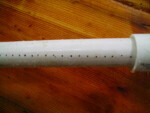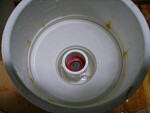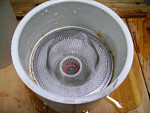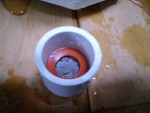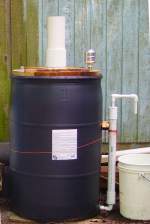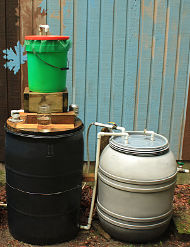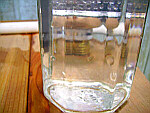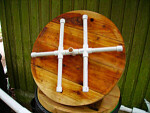|
||||||||||||||
|
|
Introduction
Water: There is only a finite amount of potable (fresh) water on this earth. Water does evaporate from the oceans, but the only way we get it is AFTER it has hit the earth and filled an aquifer, river, stream or lake. Whatever is on or in the surface that rain falls on will be in the runoff because water is able to dissolve most substances. The God given ecosphere of this earth cleans water for us with natural biological and physical processes that have been working ever since life began. This natural purification happens mainly in and near wetlands and carefully preserved forests, and to some extent, in sandy river beds. Biological sand water filters work in much the same way as a wetland. This website is about biological sand water filters. GOOD NEWS FOR RESIDENTS OF WASHINGTON STATE:note As of October 9 2009, HARVESTING RAINWATER FROM YOUR ROOF IS NO LONGER A CRIME! The department of Ecology in Washington state (the D.O.E.) has finally clarified the law so as to allow individuals to catch rainwater for their own use. (from this preceeding link, click on the links at the D.O.E. site on the upper right hand side of their page that say "new" highlighted in yellow.) Rain water harvesting laws state by state
Some modifications have been made to the baffle and input The slow sand filter and first flush diverter described here will remove petroleum hydrocarbons from water collected from the composition roof used here (to collect water) down to less than 2 parts per ten million by weight. Also the roof water filter system described on the pages of this website produces water that exceeds EPA and Snohomish county drinking water standards for absence of chemical and biological contaminants by comfortable margins. The preceeding links point to all the info (these are external links - click the back button on your browser to return here). Since this filter (filter 1) was started back in the summer of 2007, there have been more filters built that are currently operating here 24/7 along with the original "filter1". Three of these are pond filters, and 2 of them are roofwater filters, and the other 2 are shallow well water filters; filter 1 is a roofwater filter. Of the 5 non-pond filters, there have been 10 different configurations tested. Of the 3 pond filters, there have been 6 configurations tested. The filters shown on this site are not "biosand filters". The Biosand filter is a different device than what is shown here. * NOTE * (as of May 19, 2017) The filter shown on this page and referred to as "filter 1" on slowsandfilter.org, has now been in operation for 9 years and 11 months continuously not including some changes in sand size and water input methods in the first 6 months of operation. With the exception of brief below freezing weather events in the winters which have served as a sort of natural "wet harrowing"; the filter has run continuously 24/7. The flow rate has stabilized and the output water is still crystal clear and pure. I have done very little in the way of major maintanence: just cleaning out the green bucket on top (not shown here on the oldest picture),adding the green bucket, cleaning the outside of the filter barrel, and adding a larger storage container (the grey barrel). Clearing the drain pipe of small particles; and cleaing off the screen on top of the bucket is all I have done for regular maintenance, twice a year. The sand in this filter has not been changed, or replaced or deliberately disturbed during this time. The sand may never need to be replaced?. Come to think of it, how often is the sand removed and completely "replaced" in "natural" water filtration areas like riverbeds, wetlands, and underground water table areas? Probably not in a life time? Interesting. Will a slow sand filter (biological sand filter) purify water collected from a roof? Yes, under certain conditions. If you intend to use the water collected from a roof, I STRONGLY URGE YOU TO USE A "FIRST FLUSH DIVERTER"7; it will minimize the extent of dissolved chemicals from dust, pollution and roofing material in the water collected after a dry spell. Most asphalt 3 tab roofing material has a coating of inert mineral material attached to the asphalt base and may not leach significant amounts of petroleum based chemicals until it is near the end of its life and starts breaking down, or when it is very new.5 Although the water from a slow sand filter is of very high quality, I would strongly recommend the use of a UV filter followed by a ten stage carbon filter, or a "drip filter" to filter the water from the slow sand filter that you intend to use on a regular basis. Also, DO NOT DRINK OR OTHERWISE CONSUME water without first having it tested by your local health officials. Download the first flush diverter DEMONSTRATION VIDEO Also see a YouTube demonstration video of the roof water filter system here This site is about the filtration and purification of water through the use of sand, gravel and naturally occuring processes and describes how to put together a small slow sand water filter for under eighty five dollars.. The results of the tests on water run through the filter described on this website can be found here. If you want to know how well the filter works this would be the best place to start. A summary of this entire project along with details of the construction and performance of two additional filter designs can be found at slowsandfilter.org. This is a work in progress and information will be added as more investigation is done. Also, read this blog for discussion, questions, and collaboration on slow sand filters. Note: From time to time, websites describing biological sand filters / slow sand filters have been appearing with instructions recommending BACKWASHING a biological sand filter when the flow rate slows down. This is TOTALLY WRONG. DO NOT BACKWASH A BIOLOGICAL SAND FILTER - YOU WILL RUIN IT. The sand below the firs 5 or 6 centimeters has layers of biological activity that does not slow down the flow of water enough to make a difference. These layers must not be disturbed by fluidizing (backwashing) this type of filter. The flow rate is slowed by a buildup of material on the TOP FEW CENTIMETERS of sand. Simply gently agitating this layer and DRAINING OFF the cloudy water is all that needs to be done.28 (p.17, 93) These well meaning people have apparently confused rapid sand filtration with biological sand filtration. If designed correctly these biological sand and gravel filters do not need any electricticy or petroleum products to enable their operation, they work because of the pull of gravity on water and naturally occuring biological processes. If the filter and the storage containers are positioned such that the filter is higher than the storage container/s the water will flow into them and a pitcher pump can be used to extract the water from the storage container. Pathogens, and to some extent inorganic chemical pollutants, can be removed from water through the use of biologically active layers of sand in an aquatic oxygen-rich environment often called a slow sand filter, or biosand filter. Both of these types of filters are very good examples of sustainable technology as they can work wihout electricty or petrochemicals and they do not pollute or produce unusable by-products, last many years, and can be built from recycled materials. If you intend to build a filter, please read ALL of the information on this website BEFORE you start. Many sources of water, particularly in the U.S., contain chemical pollutants that require more than just a slow sand or biosand filter for their complete removal, however this is the exception rather than the rule - for now. . . . What is a slow sand filter? A slow sand filter (often called a BioSand filter, or a biological sand filter) is used to filter and clean water through the use of layers of sand and biological action. As oxygen and organisms in water pass throught the sand, a biofilm - an aquatic biological strata of living organisms in the sand - forms in the top layers of the sand as water passes through the filter. This biofilm or 'schmutzdecke' extends from the surface of the sand down 2 or 3 cm although biological activity occurs with less density at greater distances from the surface of the sand. Through biological action and some sand filtration, pathogens are rendered harmless through complex naturally occuring proceses."Viruses are effectively removed or inactivated by slow sand filtration and soil passage, but they are more resistant to UV and coagulation combined with sedimentation (9, 43, 50)." 1 The complete operation of the biological action in a slow sand filter is complex and is currently being studied by scientists; however effective filters can be built by the average person.4 A slow sand filter must maintain a constant water level above the surface of the sand; and oxygen is necessary to maintain proper operation. Slow sand filters are now gaining popularity because they do not require chemicals or huge amounts of energy to function. What is the difference between a slow sand filter and a BioSand filter? These two names both refer to a water filter that uses naturally occuring biological processes in layers of sand and gravel to purify water. A slow sand filter usually has a constant flow of water through the sand and gravel, is quite large and used to purify water for municipal water distribution systems. The concept of slow sand filtration has been around alomost as long as civilization, but there have been many improvements on the deisgn and the understanding of operation. The BioSand filter, developed by a scientist from Canada, is a modification of the slow sand filter design . It is usually much smaller and can be operated intermittantly; and it is particularly well suited for use on an individual household basis. The biofilm layer in both types of filters must be continuously covered by water but the depth of the water on top of the sand is only about 1 inch in a BioSand filter because the intermittant flow of water limits the oxygen supply. Oxygen supply is critical to keep the biofilm alive and functioning in both types of filters. A slow sand filter can be small (50 gallons) or large (public water supply). A "BioSand filter" is usually small (65 gallons or less). In both types of filters the biofilm can take up to 3 weeks to become fully effective in a newly constructed filter. How safe is the water from a slow sand filter? This is not a simple question to answer. Most importantly, DO NOT DRINK OR OTHERWISE CONSUME WATER FROM ANY OF THE FILTERS DESCRIBED ON THIS WEBSITE WITHOUT FIRST HAVING THE WATER TESTED BY, AND THE FILTER APPROVED BY, YOUR LOCAL HEALTH OFFICIALS. These filters have been in use in the U.S. since 1829; and are becoming more popular because of their ability to produce clean water acceptable to new standards set by the EPA.14 Biological sand filters are very efficent at removing disease causing bacteria from water. They remove 99.9 percent of beaver fever cysts and cryptosporidum from water. These bacteria are very resistant to chlorine in conventional water treatment and are more effectively removed by slow sand filters. Some viruses are trapped in the biofilm as their bacterial hosts are killed when they are trapped and consumed in the biolayer, however the removal of viruses by slow sand filters is still being studied. This is water purification by the removal of harmful pathogens.These filters do not add inorganic chemicals to kill organisms. Most conventional public water supply systems add chemicals such as chlorine, or ozone to kill micro-organisms and as a result chemical toxins are produced (this DOES NOT happen in a biosand, or slow sand filter) and furthermore, not all viruses are completely inactivated by chlorine. ( Not as much is known about the inactivation of viruses as is known about the removal and inactivation of bacteria in slow sand filters )8,9,10,11 In the filter described on this website, all Ecoli are removed along with all coliform bacteria. Turbidity (cloudyness) is significantly reduced. If there is at least 3 feet of sand in the filter covered by water continuously and the simple design parameters and operating instructions found on this website and in many other places on the web are followed - and the water used is free from chemical contamination, the water will be safe to use. Chemical pollutants such as heavy metals, pesticides, herbicides and petroleum contaminants are not removed as completely as pathogens and organic particles, however a significant percentage of this type of contamination is removed. IF YOU ARE PUTTING A FILTER TOGETHER FOR THE FIRST TIME, HAVE THE WATER TESTED BEFORE YOU USE ANY, and educate yourself about the operation, theory and maintenence of these filters. Many of the filter designs that are in use in parts of the world other than the U.S.have been tested and are known to work. Understanding the theory does not require a college degree. If you can read and / or use the internet, you should have enough knowledge to easily build and use one of these filters successfully. Once the filter is operational, the water is safe, but maintenence is critical and absolutely necessary, so educate yourself!! Disease causing pathogens can enter the water from anywhere. If you intend to use the water from one of these filters, be absolutely certain you have a way to test the water. If you live near a creek or small stream, the water from that source can be purified by a slow sand filter and will be safe to use - but caveat emptor - have the water tested before you use it - if it flows through a suburban or urban area in the U.S. with dwelling units near it, pathogens in the water may be the least of the problem - pesticdes, herbicides, petroleum distillates and many other chemicals and poisions may be in the water caused by runoff from roads, roofs, drainfields, and yards that have been treated with pesticides, herbicides and wood preservatives. Since many populations in the U.S. have access to thousands of "products" that contain poisons, the situation in affluent neighborhoods the U.S. is not the same as the situation in other places. In many other areas of the world the main problem with the water is biological contamination, which is easily handled by a slow sand filter; however in the U.S. and some other "advanced industrialized cultures" chemical poisions are an enormous problem and are only partially removed by slow sand filters. IMPORTANT! The roofing material on many houses in the U.S. contains poisons that kill moss. These poisons will be in the water collected from these roofs and cannot be completely removed by a biosand filter. In this part of our state there are roofing companies who advertise a moss-kill product they will apply to your roof to kill "that nasty moss that will destroy your roof". Our roof, here in the forest, was covered with moss, and lasted 30 years. The part that was in the worst shape was the part exposed to the sun - the moss was not the problem. Go figure. Composition roofing is not the best surface for harvesting rainwater because of the petroleum based chemicals (bitumens) used in the manufacture of this type of roofing material; however, most asphalt 3 tab roofing material has a coating of inert mineral material attached to the asphalt base and may not leach significant amounts of petroleum based chemicals until it is near the end of its life and starts breaking down, or when it is very new.5 As the roof material wears out, increasing amounts of these chemicals may be in the water collected from these types of roof surfaces.5 At the best, with a first flush diverter this water may be ok for temporary use, but consumed over a long period of time will be very harmful unless extensive carbon filtering is used. The biosand filter will remove the harmful pathogens very efficently and will remove most of the non-organic particles, however for drinking water the best type of roof is a metal roof called "Galvalume". It is coated with non-toxic baked on enamel. This is the type of roofing material that "green" buildings have installed. If you have a "carport" or garage with metal roofing that is not rusted and has a non-toxic paint coating (most do) that would be a good place to start and if you intend to use the water, I would still highly recommend a "first flush diverter". The roof will add no toxins however air pollution particles deposited during a dry spell will be in the first 15 or 20 gallons that run off the roof. The level of chemical pollutants from roof water will vary - if you don't have built in moss-killing poison or zinc strips on your asphalt (3 tab) roof, and it is in the "middle" of its "life" with moss growing on it, a "first flush diverter"7 will eliminate most of the harmful chemicals originating from the roof material5 and atmospheric pollution. The danger from these chemicals, since many bio-accumulate, is in prolonged exposure (as in years). If you use a 10 stage carbon filter following the slow sand filter, your water quality will probably be acceptable. The slow sand filter / biosand filter will remove nearly all the bacteria so moss on a roof is not a concern. Run the water through the biosand filter first, the bacteria will clog a carbon filter quickly. Carbon filters do not remove all the bacteria; in fact over time, bacteria will grow in a carbon filter and produce water outflow that has more contamination than the inflow. Non-toxic metal roofing can be installed over existing composition roofing material. It is slightly more expensive, but is lighter, will outlast a composition roof by 2 to three times the number of years, stand up much better in a storm, will not pollute the water that runs off of it, and metal roofing is fireproof. There are non-toxic coatings that can be applied to composition roofs that will prolong the life of the roof and allow water not contaminated with herbicide or petroleum derivatives to be collected from the roof. Also, if you have a roof without embedded moss-killing poison,(composition, fiberglass (3 tab)) a plastic tarp (check to make sure the tarp does not contain poisons) draped over the part of the roof that delivers water to your filter will help to keep most of the petroleum pollutants to an acceptable level. Even if you take water from a "non-toxic" roof, there will be poison chemicals in the water from local air pollution and small traces from atmospheric pollution. The amount will vary depending on your location. A stream that flows year round is constantly refreshing the water. A roof often sits dry for weeks or months, so pollutants build up on the roof surface and are far more concentrated in the first rain event than they would ever be in a small stream or creek several days after the first rain following a dry spell. This is why a first flush diverter is absolutely necessary. WARNING!!!!!!: Almost all racoons carry parasites in their digestive systems (Baylisascaris procyonis) often called racoon roundworms, that are usually harmless to the racoons. These roundworms each produce millions of eggs which can remain active in the environment for years. Ingestion of the active eggs of Baylisascaris procyonis can cause serious illness and there is no cure; and furthermore, chlorine, alcohol or ozone will not kill them. Young children are particularly susceptable. Roof surfaces can be contaminated by these parasites' eggs if racoons have access to the roof in question and have established a latrine on the roof (racoons often do that). Water collected from a roof contaminated with these eggs may wash them into rainbarrels. Although infection in people from Baylisascaris procyonis is extremely rare, the dire consequences warrant extreme caution. Even though a functioning slow sand filter should remove these eggs, (they are larger than 50 microns) the filters described here have not been tested for the removal of these parasites' eggs. If you have ANY racoons anywhere near your roof you must assume your roof is contaminated until it has been inspected by a professional; and be aware that a slow sand filter may not remove the parasite's eggs from the roof water unless it is functioning correctly, and that WATERING A VEGETABLE GARDEN WITH UNFILTERED WATER FROM A RAIN BARREL THAT IS CONTAMINATED WTH THE EGGS WILL LIKELY RESULT IN INFECTION AND SEVERE DISABITLIY. It should be kept in mind that infection from these parasites' eggs is rare, and that the eggs can be destroyed by boiling water. Simple precautionary measures such as hand washing and avoiding contact with contaminated surroundings will prevent infection. Please read the references listed in the following link for more detailed information: 29, 30, 31, 32, 33 New! Links to pages showing how to put rain catchment systems together: An interesting rain barrel project page This site has very detailed specific information on constructing and setting up rain barrels - the first step in getting water from a roof. Why would someone want to put one of these together? If you live in an area where water is at all an issue then there is every reason to do this. The water that runs off your roof can be collected and run through one of these filters and then be safe to use for just about anything - except drinking. DO NOT HOOK YOUR FILTER OUTPUT UP TO YOUR PLUMBING. AND, FURTHERMORE DO NOT DRINK WATER FROM ANY FILTER (INCLUDING ANY OF THE FILTERS DESCRIBED ON THIS WEBSITE) WITHOUT FIRST CHECKING WITH THE PROPER HEALTH AUTHORITIES. The moss-killing poison, and/or petroleum based pollutants present in roofing material will end up in the water that that runs off of many, if not most roof asphalt surfaces and as a result will be concentrated in the ground around the houses that have them, or worse; in many cities this water goes directly to the storm drain where the chemicals do not have a chance to biodegrade (if indeed they actually do break down in the soil). From the storm drain, the water from thousands of roofs often goes directly into rivers and streams. Now that there are droughts in many places in the U.S. we, as a nation, have to face our own arrogance in neglecting to think ahead. If our roofing materials were not designed such as to leach poisons, there would be a lot more water available at far less expense for us all. But then hindsight is always 20/20 . . . In the metro areas of most cities, during a dry spell water is rationed. If you have a flower garden, or a vegetable garden, this water from a slow sand filter can be used for that purpose. After you have set up the collection system and the filter the water is free. Ten 55 gallon drums can hold a lot of water. Simply collecting the water that runs off your roof is ok, but if anyone ingests it they could get very sick. Once the water has been run through a functioning slow sand filter it is much safer than untreated water. ( remember: The water from a roof is not the same as the water from a creek or small stream. ) If I lived in Arizona, Nevada, or any of the dry hot areas of the southwest U.S. I would consider something like this an absolute necessity, and I would have a storage tank of very large capacity to hold the filtered water. Several inches of rain on the average roof can yield thousands of gallons of water. (do the math here). If you are careful about the material used on your roof this water could be used, but I would have it tested first; however, as evidenced by the information at the links above, BioSand filters are now being used in many areas around the world to make water safe. At the risk of sounding ultra-paranoid, the following must be considered: It is important to know the condition of the environment from which the water is being taken. The situation in the location of this filter is unique in that the water collection surface is surrounded by trees and a large wildlife area located in the northwestern part of the U.S. . If water from a slow sand filter system similar to this one in surroundings and design is to be used on a regular basis, it would be adviseable to run the water through a uv (ultra-violet) filter following the output from the slow sand filter In other areas of the world the situation will very likely be quite different. The operation of these biological sand filters has been documented with repeated investigations and tests showing the same result: Disease causing organisms are removed through naturally occuring processes; and turbidity is reduced to the extent that the water is safe to use. This website is documentation of one more independent observation that shows the same result as the others. When properly constructed and maintained, biological sand filters work as claimed regarding the removal of bacterial pathogenic organisms. All of The test results can be seen here (a large image file). For those who are interested in the Laboratory doing the testing; I will supply the other details on request.  note Why is this "good" news? 1. Enough water for survival should be free for everyone. It is as necessary for life as air - that one is sort of a no brainer. 2. If enough people in the city catch rainwater in rain barrels, the load on the storm drains is reduced considerably - and there is less chance of the drains overflowing and spreading contaminated water into the environment before it is treated. This is good news for everyone, as less pollution is washed into streams, rivers, lakes, and oceans during a significant rain event. 3. In the summer, water can then be conserved by using the stored water for flower gardens, lawns, and if filtered by a slow sand filter, vegetable gardens can also be irrigated; thereby significantly reducing the load on the public water supply. 4. Most importantly, it appears as though government is finally getting a clue. . . hopefully I'm not wrong about this. Good job Wa. state gov., thank you! Tax dollars well spent this time! WARNING: DO NOT WATER VEGETABLES WITH WATER STRAIGHT FROM A RAIN BARREL, AND NEVER - EVER CONSUME WATER FROM A RAIN BARREL. ROOFTOPS COLLECT LOTS OF PATHOGENS (HARMFUL BACTERIA AND VIRUSES) AND POISONS THAT WILL MAKE PEOPLE VERY SICK. A first flush diverter and a slow sand filter, at the very least, must be used if vegetables are to be safely irrigated using water from rain barrels. Read this slow sand filter faq page before you set up rain barrels. back to top back to top |
|
|
|||||||||||
|
Page design by Perpetual PC's  This work is licensed under a Creative Commons Attribution-ShareAlike 2.5 License. terms of use |
||||||||||||||

